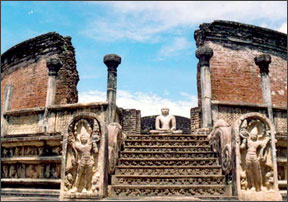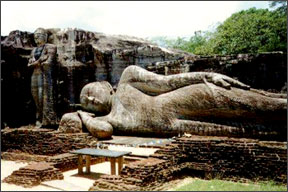Lanka's awe-inspiring Cultural Triangle
Dr. Sanjiva Wijesinha
In Sri Lanka's sparsely populated north-central plains - aptly termed
the nation's Cultural Triangle - a remarkable cluster of UNESCO World
Heritage sites offers a glimpse of life a thousand years ago in one of
the world's first great Buddhist kingdoms.
|

Polonnaruwa Watadage |
While Europe was still in the Dark Ages, the Lankan kings who ruled
this land created innovative irrigation systems that made the landscape
bloom - and then beautified it with magnificent royal palaces and places
of worship.
Here, on the terrace of the Heritance Kandalama Hotel that overlooks
a vast, man-made lake (man-made in the fifth century), I am seated with
the setting sun turning the horizon into brilliant pastel shades of
orange and pink in front of me.
On the rocks to my left, an old man is seated, the haunting music of
his wooden flute weaving its magic as dusk falls and the smell of wood
smoke fills the air. As I sip my glass of iced mango juice, I find
myself reflecting on what a wonderful world I happen to be occupying at
this moment.
Beautiful frescoes
I had spent that morning visiting Sigiriya, the fifth century rock
fortress built by King Kasyapa. Having usurped the throne in 477 AD and
condemned his father to death, Kasyapa lived in constant fear of his
avenging brother - and so built himself a fortified palace (some might
call it a fifth century penthouse) atop the massive Sigiriya Rock.
The ruins of his palace at the summit are reached by a path that
takes you past moats, pleasure gardens and fountains as well as walls
(actually the plaster covered face of the rock) on which are found some
of the most beautiful and best preserved fresco paintings in Sri Lanka.
Designated a UNESCO World Heritage Site in 1982, Sigiriya is a must-see
for any visitor to this island.
 A short drive from Kandalama is the ancient rock temple of Dambulla,
another of the Cultural Triangle's World Heritage Sites. The "temple"
actually consists of five rock caves. Three of these caves date back to
the first century BC, two others having been added in the late 18th and
early 20th centuries. A short drive from Kandalama is the ancient rock temple of Dambulla,
another of the Cultural Triangle's World Heritage Sites. The "temple"
actually consists of five rock caves. Three of these caves date back to
the first century BC, two others having been added in the late 18th and
early 20th centuries.
The original temple was constructed by King Valagamba, who, having
lost his kingdom to invaders from South India, took refuge in these
caves for 15 years.
On regaining his throne, he established a Buddhist temple here,
covering the cave walls and ceilings with paintings from the scriptures
and filling the caves with innumerable statues of the Buddha - some
carved in granite, others made of bricks and mortar and yet others of
wood coated with plaster.
Unlike the man-made cave temples of Ajanta and Ellora, these are
natural caves which colourful wall paintings and votive statues have
converted into places of contemplation and worship.
The Triangle includes two other ancient capitals, Anuradhapura and
Polonnaruwa, both UNESCO World Heritage sites. Anuradhapura was Sri
Lanka's first capital, being established around 500 BC, and has some
unique places of Buddhist worship.
Early mornings, if you walk to the Sri Maha Bodhi - the magnificent
sacred Bo tree, grown from a sapling of the very tree at Bodhgaya in
Bihar under which the Buddha attained enlightenment - you will witness
pilgrims at their devotions, much the same as their forefathers have
been doing for the past two thousand years.
Impressive Stupas
Polonnaruwa was Sri Lanka's capital from the 11th to the 14th
centuries, and still boasts some of the world's most impressive Buddhist
stupas. One, the Gal Vihara, has four large statues carved from the rock
face.
Visitors here cannot help but stand in awe of the sculptors who
created these lifelike images, admiring in particular the statue of the
Buddha's disciple Ananda, a look of abject sadness on his face as he
stands vigil over the dying Buddha. Another stupa, Jetavanaramaya,
rivals in size the largest of the Egyptian pyramids.
Recently restored under the UNESCO Cultural Triangle project, it
bears silent testimony to the civilisation that flourished in these
plains while Europe was still in the Dark Ages.
The flautist has finished his performance and gets up to leave. I
drain the last of my drink but decide to linger longer. In a short while
I will have to get up and leave, but not yet.
The Hindu
|

